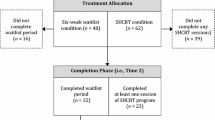Abstract
In view of the increasing popularity of minimal intervention treatments for problem drinking, a self-help manual for people who wish to reduce or stop gambling was prepared. Twenty-nine (ACT residents) who responded to advertisements for help with problem gambling were allocated to either of two minimal treatments, “Manual (only)” and “Manual & Interview”. On average, clients from both groups reduced the frequency of their gambling sessions, frequency of overspending, and amount spent per week in the first three months and next three months after first contact, but expenditure per session increased from three to six months, after an initial improvement. There was no evidence that a single in-depth interview added to the effectiveness of the manual.
Similar content being viewed by others
References
Aitken, R. (1969). Measurement of feeling using Visual Analogue Scales.Royal Society of Medicine Proceedings, 62, 909–996.
Billings, A.G. & Moos, R.H. (1983). Psychosocial processes of recovery among alcoholics and their families: implications for clinicians and program evaluators.Addictive Behaviors, 8, 205–218.
Blaszczynski, A. (1985). Treatment approaches for the control of pathological gambling. In G. Caldwell, M.G. Dickerson, B. Haig, & L. Sylvan (Eds.)Gambling in Australia, (pp. 172–182) Sydney: Croom Helm.
Cameron, D. (1985). Why alcohol dependence—and why now? In N. Heather, I. Robertson & P. Davies, (Eds.)The Misuse of Alcohol, (pp. 59–71). London & Sydney: Croom Helm.
Corless, T. (1987).An investigation of impaired control in gambling behaviour: with specific reference to impaired control as a diagnostic criterion in DSM III “Pathological Gambling“. Unpublished Masters thesis, Department of Psychology, Australian National University.
Cornish, D.B. (1978).Gambling: a review of the literature and its implications for policy & research. London: HMSO.
Crowne, D.P. & Marlowe, D. (1964).The Approval Motive: Studies in Evaluative Dependence. New York: Wiley.
Custer, R.L. (1982). An overview of compulsive gambling. In P.A. Carone, S.F. Yolles, S.N. Kieffer & L.W. Krinsky (Eds.)Addictive Disorders Update. New York: Human Sciences Press.
Dickerson, M.G. (1984).Compulsive Gamblers, London: Longman.
Dickerson, M.G. (1986). Problem gambling: A self-help manual for controlling or stopping the amount you spend on gambling, unpublished manuscript. In C. Allock & M.G. Dickerson,The Guide to Good Gambling, (pp. 160–193). Wentworth Falls, Australia: Social Science Press.
Dickerson, M.G. (1987). The future of gambling research-learning from the lessons of alcoholism.Journal of Gambling Behavior, 3, 248–256.
Dickerson, M.G. & Hinchy, J. (1988). The prevalence of excessive and pathological gambling in Australia.Journal of Gambling Behavior, 3, 135–151.
Dickerson, M.G., Legg England, S. & Hinchey, J. (1989). Pathological and social poker machine players; some empirical data on individual differences, (in preparation).
Dickerson, M.G. & Weeks, D. (1979). Controlled gambling as a therapeutic technique for compulsive gamblers.Journal of Behavior Therapy and Experimental Psychiatry, 10, 139–145.
Glasgow, R.E. & Rosen, G.M. (1978). Behavioral bibliotherapy: A review of self-help behavior therapy manuals.Psychological Bulletin, 85, 1–23.
Heather, N. (1986). Minimal treatment interventions for problem drinkers. In G. Edwards & D. Gill (Eds.)Current Issues in Clinical Psychology (pp. 120–156) (Vol4). London: Plenum.
Heather, N. & Robertson, I. (1983).Controlled Drinking, London: Methuen.
Heather, N., Whitton, B. & Robertson, I. (1986). Evaluation of a self-help manual for media recruited problem drinkers: Six-month follow-up results,British Journal of Clinical Psychology, 25, 19–34.
Lesieur, H.R. (1988). Altering the DSM-III criteria for pathological gambling.Journal of Gambling Behavior, 4, 38–47.
Miller, W.R. (1983). Motivational interviewing with problem drinkers.Behavioural Psychotherapy, 11, 147–172.
Miller, W.R., Gribskov, C. & Mortell, R. (1981). The effectiveness of a self-control manual for problem drinkers with and without therapist contact.International Journal of Addictions, 16, 829–39.
Miller, W.R., & Taylor, C.A. (1980). Relative effectiveness of bibliotherapy, individual and group self-control training in the treatment of problem drinkers.Addictive Behaviours, 5, 13–24.
Nadler, L.B. (1985). The epidemiology of pathological gambling: Critique of existing research and alternative strategies.Journal of Gambling Behavior, 1, 35–50.
Orford, J. (1985).Excessive appetites: A psychological view of the addictions. Chichester: Wiley.
Orford, J. & Edwards, G. (1977).Alcoholism: A comparison of treatment and advice, with a study of the influence of marriage. Oxford: Oxford University Press.
Pols, R.G. & Hawks, D.V. (1987).Is there a safe level of daily consumption of alcohol for men and women? Canberra: Australian Government Publishing Service.
Prochaska, J.O. & Di Clemente, C.C. (1986). Toward a comprehensive model of change. In W.R. Miller & N. Heather (Eds.)Treating Addictive Behaviours, (pp. 5–27). New York and London: Plenum.
Rankin, H. (1982). Control rather than abstinence as a goal in the treatment of excessive gambling.Behaviour Research and Therapy, 20, 185–187.
Rachman, S.J. & Wilson, G.T. (1980).The effects of psychological therapy. Oxford: Pergamon.
Robertson, I. & Heather, N. (1987).Lets drink to your health!-a guide to safe and sensible drinking (adapted for Australia and New Zealand by D. Watts). Sydney: Angus & Roberston.
Rosen, G.M. (1987). Self-help treatment books and the commercialisation of psychotherapy.American Psychologist, 42, 1, 46–51.
Saunders, W. & Kershaw, P. (1979). Spontaneous remission for alcoholism: Results from a community survey.British Journal of Addiction, 74, 251–265.
Tuchfield, B. (1976).Changes in the patterns of alcohol use without the aid of formal treatment, North Carolina Center for Health Studies, Research Triangle Institute, North Carolina.
Volberg, R.A. & Steadman, H.J. (1988). Refining prevalence estimates of pathological gambling.American Journal of Psychiatry, 145, 502–505.
Author information
Authors and Affiliations
Additional information
This project was funded by a grant from the Australian National University Faculties Research Fund.
Rights and permissions
About this article
Cite this article
Dickerson, M., Hinchy, J. & Legg England, S. Minimal treatments and problem gamblers: A preliminary investigation. J Gambling Stud 6, 87–102 (1990). https://doi.org/10.1007/BF01015751
Issue Date:
DOI: https://doi.org/10.1007/BF01015751




